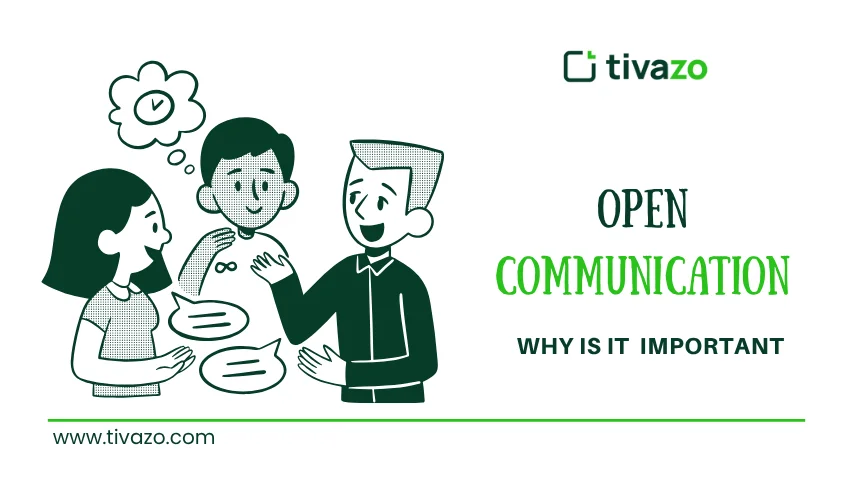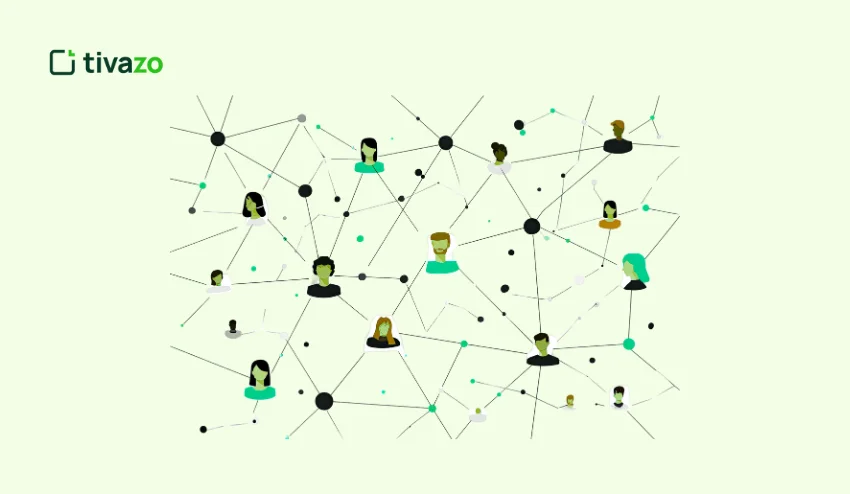Why Is Open Communication Important? Open communication is essential to any thriving organization. In today’s fast-paced and competitive business environment, transparency and effective communication are more crucial than ever. It can help you deal with common workplace struggles and drive productivity, whether you have a team that is working remote from home or you’re in the office together. But, why is open communication important? Let’s review five ways that it will transform your organization to be more successful and better unify your teammates.
This not only enhances daily work but contributes to increasing your company’s culture. When this takes a front seat, workers feel respected and are more willing to work together and share out-of-the-box ideas. It essentially begins to create a continuous loop of improved communication that leads to better trust and efficiency within teams.
Key Highlights:
- What Is Open Communication
- Key Elements of Open Communication
- Benefits of Open Communication in the Workplace
- Role of Technology
- Promote Open Communication in Your Organization
- How Open Communication Impacts Organizational Success
What Is Open Communication?
Open communication is the practice of sharing information, concepts, input, and worries in a forthright and approachable way. It engages active listening, empathy, and involvement of team members and leaders. Employees who believe their voice is heard will be more inclined to assist in the company’s success, as well as an environment that nurtures trust and collaborates to reach more qualified decisions. Open communication also helps to avoid misunderstandings and brings additional clarity to ensure that each individual is aligned with the company’s purpose and values.
Key Elements of Open Communication:
Open communication is more than just speaking; it is the establishment of two-way communication, which acknowledges every voice. To truly embrace culture, some fundamental elements must come into play. These elements guarantee that there is a flow of information, and that everyone is heard and feedback is used for improvement, not simply chastisement.
- Active Listening: Listening to comprehend rather than to respond.
- Transparency: Openly communicating information across all organizational levels.
- Feedback Culture: Promoting the idea of constructive feedback and being open to suggestions.
5 Key Benefits of Open Communication in the Workplace (H2)
Have you ever thought why is open communication important? Here are 5 Major Advantages of Open Communication in the Workplace:
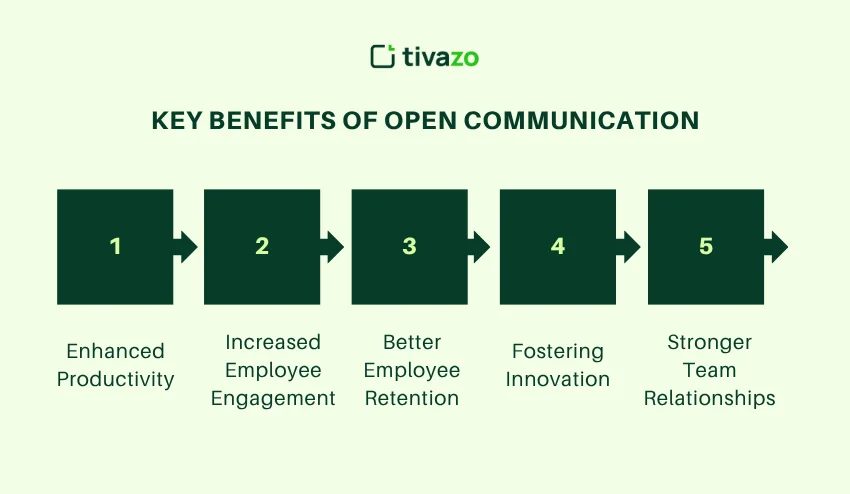
1. Enhanced Productivity
Why is open communication important? it contributes to increased productivity. A McKinsey report mentioned that teams using open and transparent communication are five times more likely to see increases in productivity. Employees who feel included in decision-making and have a clear understanding of goals are better prepared to get certain aspects of their work done.
When communication is clear and aligned it produces less of misunderstandings as well as less delays and interruptions allowing for more efficient workflows across teams.
2. Increased Employee Engagement
The disengaged workforce costs businesses $ 8.8 trillion a year, according to a Gallup study. Open communication where employees feel valued and heard will raise employee levels of engagement. When employees are involved in discussions, ideas are shared and employees see how their work fits into the organization’s purpose and goals it raises engagement and commitment levels.
Engaged employees create a positive work environment, improve morale, and raise job satisfaction which all lead to better job performance.
3. Better Employee Retention
When employees believe that their voice is heard, and transparency exists at the leadership level, they are more likely to stay longer. The Microsoft 2022 Work Trend Index revealed that 80% of employees are more likely to stay in their job if they feel transparent support. When teams are empowered to speak openly, employees perceived as valued at work are more likely to remain, positively contributing to engagement.
Communication culture can significantly increase retention rates, which lowers recruiting costs while ensuring talent remains in your organization.
4. Fostering Innovation
So why is open communication important? Open communication supports freedom in exchanging ideas, which is essential for problem-solving and innovation. Once an employee feels free to share their thoughts and ideas (whether out of the box or not), ideas will generate insight and creative opportunity.
Free exchange of ideas supports a culture of continual improvement when teammates at all levels to proceed actively in ongoing problem-solving and decision-making. A company with a dynamic exchange of ideas fosters positive organizational change with new ideas toward solving problems or coming up with innovate solutions.
5. Stronger Team Relationships
Teams that communicate effectively are better at resolving disagreements and cultivating stronger professional relationships. Research shows that teams that communicate well have a greater ability to collaborate, problem solve, and support one another. Open communication helps break down cultural barriers in the workplace, creating alignment and cooperation, and developing trust among team members.
This results in a stronger and more cohesive work culture; people will want to support others’ success and work toward shared goals.
Overcoming Communication Barriers
Organizations are aware of the benefits, but it can be challenging to bring this to fruition within an organization. Many communication barriers often present themselves in organizations fear of feedback, culture, and hierarchy. Each of these barriers, in turn, can adversely impact openness to communication, decrease trust in one another, and limit open communication, collaboration, and innovation. Regardless, with the right tools, these barriers can be overcome to help teams communicate openly as well as efficiently. Here are some of the communication barriers we face in the workplace.
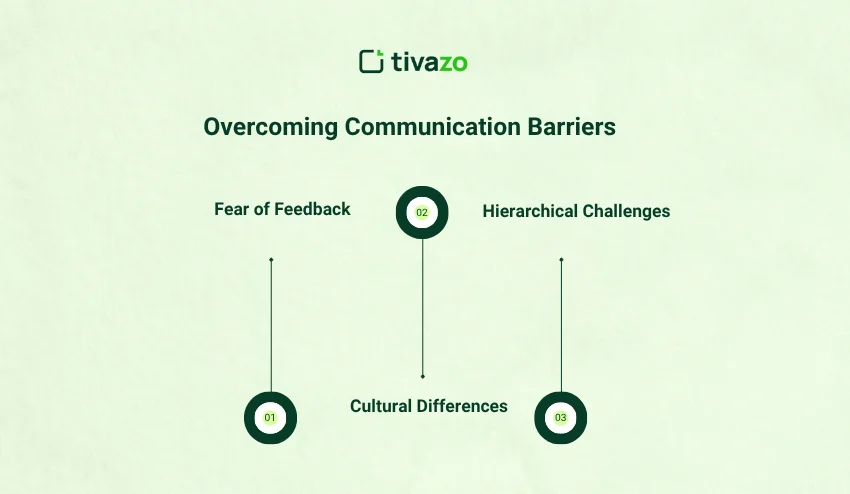
- Fear of Feedback: Often employees have some fear associated with both giving and receiving feedback. You may want to build a culture around feedback where nobody feels that mistakes can’t be used as a learning opportunity.
- Cultural Differences: Culturally teams from other backgrounds could be having a hard time with ad hoc transmissions. Develop training programs to encourage tolerance of other cultures and responsible conversation.
- Hierarchical Challenges: Traditional corporate hierarchies can block lines of communication. Foster an open-door policy and urge leadership to have honest conversations on all levels.
The Role of Technology in Facilitating Open Communication (H2)
In a digital age, technology helps in setting up channels of this kind of communication, particularly when a team is remote or hybrid. Here are some ways tech tools can help foster the changing of values in organizational culture:
- Collaboration Tools: Systems such as Slack, Microsoft Teams, or Zoom can help teams to communicate more effectively, even in a distributed setting.
- Feedback Channels: For example, using tools like SurveyMonkey or Google Forms to collect anonymous feedback, this may be very valuable if the sincerity of communication is important.
- Project Management Tools: Tools like Trello, Asana, or Monday.com help teams stay aligned and transparent about deadlines, goals, and responsibilities.
How Open Communication Drives Employee Well-Being (H2)
Why is open communication important? It’s not just professional development, it’s also employee health. When workers get a sense of certainty in their role, they feel that they are being listened to and can voice any concerns in complete freedom; such an environment is an environment where support and relaxation go hand-in-hand. Promoting open and transparent talking in organizations about these very personal subjects can, perhaps surprisingly, help to positively impact mental and emotional health at work for employees, and happy employees are more productive ones. Here’s why this communication is good for you:
- Stress Reduction: When employees are clear about their roles and expectations, they experience less stress and anxiety.
- Work-Life Balance: Open discussion about workloads and boundaries allows employees to better manage their time, mitigating burnout.
- Job Satisfaction: Listening and valuing bring job satisfaction, as well as overall morale, which increases employee retention.
How to Promote Open Communication in Your Organization (H2)
Fostering a culture of open communication will take some intentionality and planning. Below are eleven action steps to facilitate open communication in your organization.
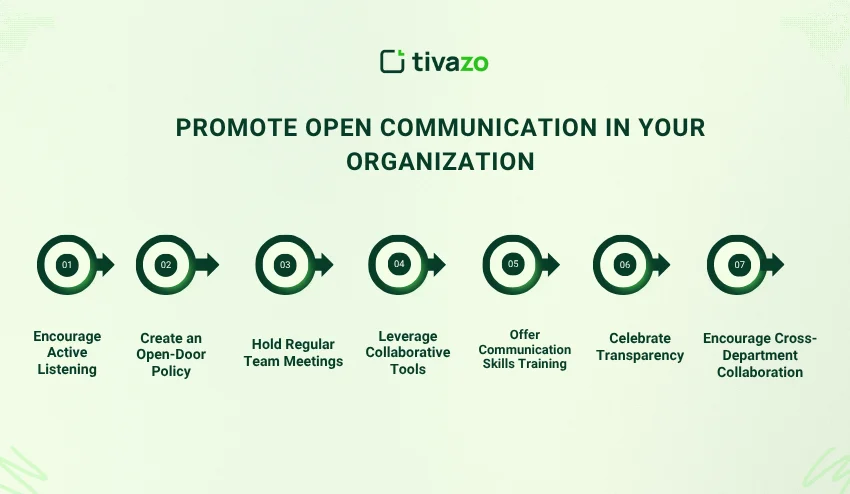
1. Encourage Active Listening
Educate workers to listen actively and appreciate their coworkers’ opinions instead of judging them. This will assist in establishing an environment where every voice is valued. When workers are trained to listen actively, they will do a better job of processing others’ perspectives, allowing for thoughtful responses, collaboration, and reduced misunderstanding.
2. Create an Open-Door Policy
Management should welcome employees to provide feedback, ask questions, and have open conversations without fear of retaliation. An open-door policy should be shared frequently and in multiple ways, so that employees know they can approach leadership with their thoughts or concerns without consequence. When employees know they are being heard, trust increases within the organization.
3. Hold Regular Team Meetings
Regularly schedule check-ins (e.g., staff meeting, town hall) for teams to share updates, concerns, and collaborate on solutions. Regularly scheduled team meetings allow employees to stay aligned with goals and offer transparency. Regularly scheduled meetings also ensure that everyone is informed of team conversations, making all members of the team feel part of the larger decision-making process.
4. Leverage Collaborative Tools
Collaborate with employees through platforms such as Slack, Trello, or Asana. These applications allow employees to share information, ask questions, and work together across departments, and also allow the team to stay organized by being able to keep all discussions, including important feedback and conversations to specific topics, out of email threads.
5. Offer Communication Skills Training
Equipping employees with effective communication skills, whether it is through active listening or giving and receiving feedback. This training should be continuous, allowing employees to fine-tune and develop their interpersonal communication skills, individually or in groups, which can then promote a culture of effective communication skills with others.
6. Celebrate Transparency
Every time you congratulate an employee or leader who models transparency, you reinforce the positive value of transparency within the organization. Public acknowledgment might create an environment be filled with more acknowledgment and motivate individuals to become the next transparency role model.
7. Encourage Cross-Department Collaboration
Organizations are guilty of creating silos, encouraging departments to communicate and possibly collaborate on inter-department projects. Outfitting employees from different departments fosters new perspectives as well as better interdepartmental relations, open collaborations, and the spread of ideas, which typically generates an atmosphere for innovation and ultimately introduces new solutions and ideas for holistic problems
Tools and Resources for Enhancing Communication (H2)
Here are a number of tools and resources that can support communication in your organization:
- Slack: Slack is a great messaging and collaboration tool that makes open and real-time communication easy to achieve. Teams can create channels for specific functions or projects to share updates and collaborate. Conversations and shared files are easy to find and also search for in Slack.
- Trello: Trello is a user-friendly project management tool. Trello helps teams understand which tasks are what actions by creating a project board for each project. Teams can assign who is responsible for a task, update as needed, and follow due dates. Trello keeps all team members informed and on the same page regarding tasks for collaboration and communication.
- Microsoft Teams: Microsoft Teams provides a central platform for communication, video meetings, and file sharing. Teams is perfect for remote teams, where integration with the Microsoft Office suite is seamless. Teams helps employees stay connected, work together, and get access to important documents.
Conclusion
Why does open communication matter? Open communication is critical to the success of any organization and helps to increase productivity, enhance morale, stimulate innovation, and strengthen team dynamics. By using the strategies provided in this post, you can start to build a culture of openness and trust that is most likely to lead to better outcomes for your organization.
If you want to experience these positive benefits, use these strategies starting today and see your teams thrive.
